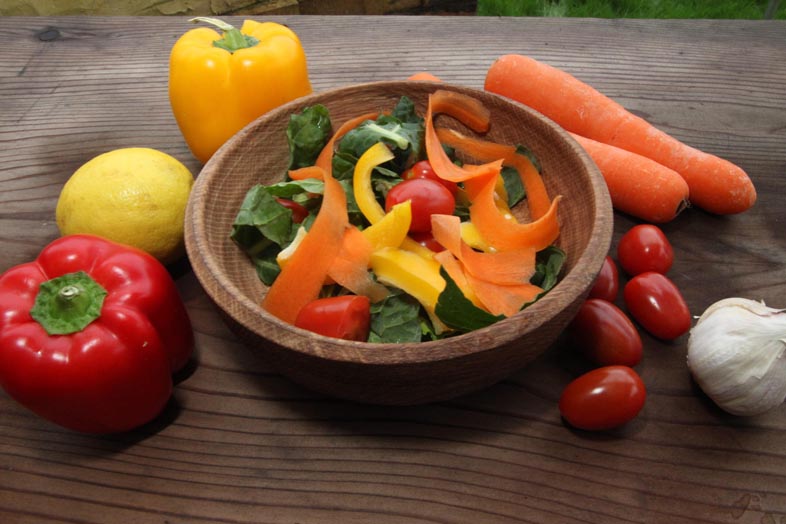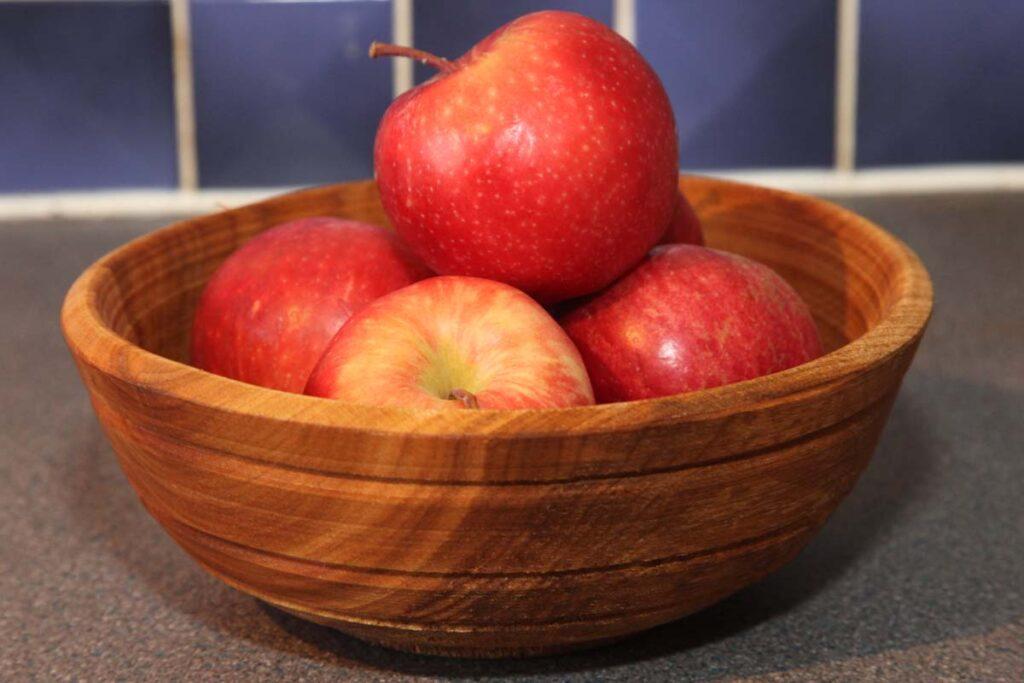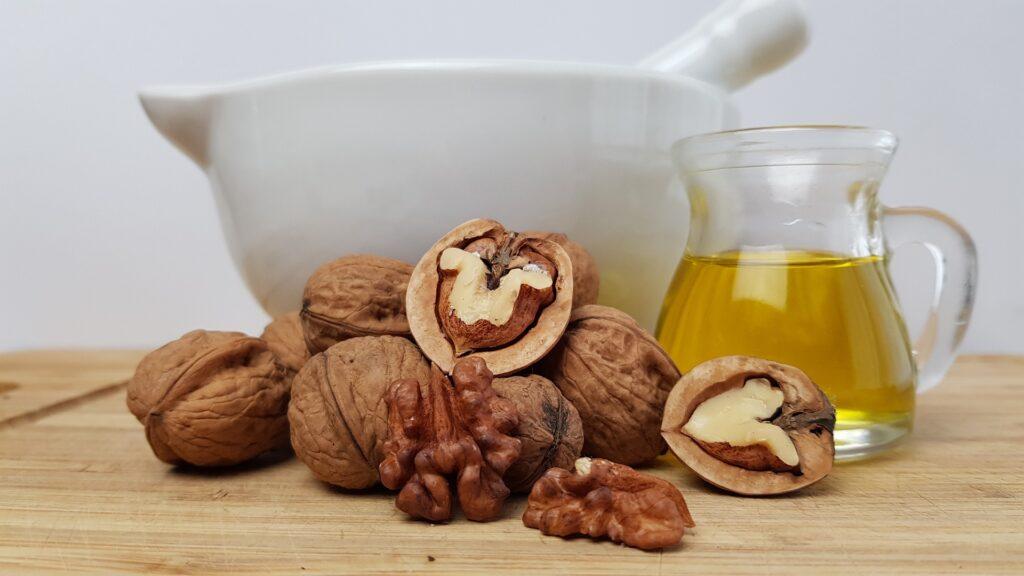
Wooden bowls have been used for centuries as a way to eat, serve, and store food. They are a simple and elegant way to enjoy your meal. There are many different types of wood bowls, each with its own unique grain and colour. Whether you use them for everyday dining or special occasions, wood bowls are a beautiful addition to any table. So read on for the answer to the question, can you eat from a wooden bowl?
The benefits of wooden bowls
There are many benefits to using wooden bowls. They are durable, eco-friendly, and look great. Wooden bowls can be used decoratively or for serving food. They are a natural way to add beauty and style to your kitchen.

Wood is a natural material.
Once its useful life as a bowl is over, the wood is naturally biodegradable. It will return to the earth and help by returning nutrients to the soil. It is also renewable as it can be replaced by growing more.
Wood is calming
It is worth picking up a wooden bowl to experience how tactile wood as a material is. Using wood can remind us of the links we have with nature in a way that other materials can.
Proper Care for Your Wooden Bowls
With proper care, your wooden bowls can be passed down the generations. Wooden tableware is long-lasting and can withstand the stress of daily use. They aren’t indestructible but will withstand being dropped and knocked without chipping. It is also possible to reinvigorate a wooden bowl by oiling it.
Wood is Eco Friendly
Using wood from a sustainable source is important. Yet wood’s eco-friendly credentials really come into their own when you consider the sheer number of processes involved in oil extraction and refinement, and the manufacturing processes involved in producing plastic alternatives.
Are wooden bowls safe to eat from?
Like most people, you probably think eating from a wooden bowl is a bad idea. After all, wood is porous and full of tiny crevices that can harbour bacteria, right? Wrong! Wood is a surprisingly good material for food contact surfaces. It has many advantages over other materials like plastic and ceramic. For example, these small oak bowls are ideal for porridge. The wooden bowl isn’t cold like a ceramic bowl and insulates you from the food’s heat. The same goes for the larger 8-inch bowls, which are ideal for stews or soap and cold food.
A wooden bowl may not be the first thing that comes to mind when you think of cooking utensils, but they can be quite versatile. You can use them for both hot and cold dishes, and they’re perfect for everything from soup to cereal. Plus, they’re eco-friendly and look great on your table. But before you start using your wooden bowl for everything, you should know a few things about cleaning and care.
Are wooden bowls safe for hot food?
Wooden bowls can be safe for hot food, but it depends on the type of wood and how the bowl is made. Hardwoods, such as maple and oak, are more heat-resistant than softwoods, like pine or cedar. Additionally, properly seasoned and oiled bowls are less likely to absorb moisture and are therefore less likely to warp or crack when exposed to hot food.
It is important to note that wooden bowls should never be placed in the dishwasher or exposed to prolonged periods of high heat, such as in an oven or microwave. Hand-washing with warm, soapy water and drying thoroughly is recommended to maintain the integrity and safety of the bowl.
The history and significance of handmade wooden bowls
Handmade wooden bowls have a rich history that spans centuries and all of the regions in the UK. They have been used for various purposes throughout different cultures and civilizations. In ancient times, wooden bowls were not only functional but also symbolic. They were often seen as vessels of abundance and prosperity, used to hold food and offerings during religious ceremonies.
The significance of handmade wooden bowls lies in their connection to nature and the craftsmanship involved in their creation. Unlike mass-produced items, these bowls are made by skilled artisans who have honed their craft over years of practice. Each bowl is a unique piece of art that reflects the personality and creativity of its maker. The process of creating a handmade wooden bowl requires patience, precision, and a deep understanding of the characteristics of the wood being used.
Wooden bowls also have a timeless appeal that transcends trends and fads. They evoke a sense of warmth and authenticity, reminding us of a simpler time when things were made to last. In today’s fast-paced world, owning a handmade wooden bowl can be a way to reconnect with nature and appreciate the beauty of natural materials
Changing fashions
Wooden bowls started to fall from favour with the introduction of cheaply produced porcelain bowls. Rather than relying on wooden bowls made in the UK, manufacturers started producing uniform mass-produced tableware quickly and cheaply.
Thankfully, today, the fashion for mass-produced items is being questioned by more and more people. There is now a thriving community of UK-based artisans making beautiful handmade wooden bowls.
How to care for a wooden bowl daily
Wooden bowls are a beautiful and unique addition to any kitchen. They can be used for serving food, as decoration, or even as fruit bowls. But like any wood product, they require special care to keep them looking their best. Here are some tips on how to care for your wooden bowl:
- Wash with warm soapy water and dry thoroughly after each use.
- Avoid using harsh chemicals or scrubbing pads that could damage the finish.
- To remove stains, rub with a mixture of equal parts vinegar and drying oil (keep reading for info on drying oils).
- as needed, apply a thin layer of drying oil to the bowl with a soft cloth to help protect the wood and keep it from drying out.
- Store your wooden bowl in a cool, dry place away from direct sunlight.
Do wooden bowls hold bacteria?
You may have heard that wood is a naturally antibacterial material. And it’s true! Wood is less likely to harbour harmful bacteria than other materials like plastic.
But that doesn’t mean wooden bowls are completely bacteria-free. If you’re using them to prepare and serve food, it’s important to wash them just like you would any other dish.
With proper care, wooden bowls can be a beautiful and practical addition to your kitchen. Just remember to clean them regularly and watch for any signs of wear or damage.
Are wooden bowls hygienic?
The short answer is yes, wooden bowls are hygienic. Therefore you can eat from a wooden bowl. Wood is a natural material that is resistant to bacteria and other microbes. You can clean wooden bowls with soapy water, however, wooden bowls shouldn’t really be put in the dishwasher as this will damage the bowl’s finish.
However, there are a few things you should keep in mind to keep your wooden bowl hygienic. First, don’t let food sit in the bowl for too long. Second, don’t use harsh chemicals or abrasive scrubbers on the bowl. Third, if you want to reinvigorate your bowl you can apply a coat of oil.
Wooden bowls – aftercare tips
Part of the appeal of wooden bowls is that it is simple to look after them. As earlier mentioned in the daily care of wooden bowls you should use warm soapy water to clean your bowl and you should use vinegar and a drying oil to remove stains.
Read on for information on looking after your bowl to keep your bowls looking good.
What oil can I use on my wooden bowl?
Wooden bowls are beautiful. But, like all wood products, they require special care to keep them looking their best. One of the most important things you can do for your wooden bowl is to oil it regularly. But what kind of oil should you use? The right oil for your wooden bowls
Many different types of oil can be used on wooden bowls, but not all of them are created equal. Some oils will leave your bowl looking dull and lifeless, while others will bring out the natural beauty of the wood grain. Each one has its own benefits, strengths, and weaknesses. You’ll find these oils listed below along with some of the best options available.
The best oils for wooden bowls are linseed, walnut, Tung, or grapeseed oil. At JB Woodcrafts we treat the bowls with either walnut oil or tung oil.
The worst oils to use on wooden bowls include olive, vegetable, or sunflower oil as these don’t try out. They will be absorbed into the wood. Over time these will go rancid and the bowl will smell bad and potentially have a hard but sticky yellow film on its surface. However, it is perfectly alright to use olive oil as a salad dressing, we simply mean the bowl shouldn’t have olive oil or similar applied and left to soak into the wood.
We also don’t recommend products such as mineral oil or butcher’s block oil. Whilst these are food safe, they are derived from the petrochemical industry – personally, I’d prefer something more natural. They can also make a bowl feel a little slippery or greasy, whilst this is fine for a chopping block – it’s not what I’d want from a bowl.
Food-safe Linseed Oil
Also known as flaxseed oil, linseed is a popular choice with bowl turners to protect their bowls. As long as you don’t use boiled linseed (this has drying agents added to it) you can use it to protect and revitalise a wooden bowl. The downsides include the possibility of a yellowing discolouration and a strong smell.

Walnut Oil
Walnut oil is one of my preferred choices to protect my bowls. It penetrates deep into the wood and dries forming a satin finish that is long-lasting and brings out the best in the wood’s grain. Whilst it does darken the wood, it does not interfere with the beauty of the grain. The best part is that it can be used on the entire piece and will not leave behind any oily residue. For my bowls, I lightly coat them in several thin layers for a deep satin shine.

Tung Oil
Tung Oil or China wood oil is a drying oil made by pressing the seeds from a tung tree. Similarly to walnut oil, it is a polymerising oil that will form a protective layer for your wooden bowl and enhance the bowl’s appearance by bringing out the grain of the wood. When using tung oil on food contact surfaces like bowls, you must be using 100% pure tung oil. This is because some brands call their product tung oil, but it’s either a different kind of oil or it has drying agents added to it, thereby rendering it unsafe for use on surfaces that come into contact with food.
What about nut allergies?
There is a conceivable risk of those with a nut allergy reacting to a bowl finished with walnut oil. However, this is a much smaller percentage of the population than those also allergic to peanuts (which aren’t really nuts).
Tong oil is made from the seed of the Tong tree, and whilst there can be an allergic reaction; it won’t be because of a nut or peanut allergy.
If you have any doubts about the finish on our bowls, please contact us and we can agree on an alternative such as linseed oil.
Can you reheat food in a wooden bowl in the microwave?
Well, the short answer is no. Heat is not a friend to a wooden bowl. it is possible that putting a wooden bowl in a microwave could result in a kitchen fire. In the same vein, it is highly unadvisable to place a wooden bowl into an oven to reheat or keep a meal hot.
In conclusion, wooden bowls are safe to eat from and easy to care for. So Yes! You can eat from a wooden bowl.
They are also a sustainable and eco-friendly option that can help you reduce your carbon footprint. When choosing a wooden bowl, be sure to select one that is made from durable hardwood. To keep your bowl protected and looking great, occasionally apply a thin coat of drying oil.
